Comprehensive Auditing Analysis and Report: Vintage Energy Limited
VerifiedAdded on 2022/11/19
|19
|3834
|140
Report
AI Summary
This report provides an in-depth analysis of the auditing process applied to Vintage Energy Limited. It begins with an executive summary and table of contents, followed by an introduction that explains the importance of auditing in assessing the materiality of company financial statements and the role of auditors in mitigating business risks. The report then delves into the background and industry analysis of Vintage Energy Limited, highlighting the company's challenges and risks, such as lack of business, competitive pressure, and changes in government regulations. A detailed analysis of the company's financial statements is presented, including an examination of inherent and control risks, and the application of the audit risk model. The report also includes an analytical review of the company's financial ratios, such as current, debt, and debt-equity ratios. Furthermore, it covers the planning materiality, audit planning, and assertions for key accounts like cash and cash equivalents, trade receivables, and property, plant, and equipment. The report outlines audit work steps, sampling methods, and evidence requirements for each account, providing a comprehensive overview of the audit process.
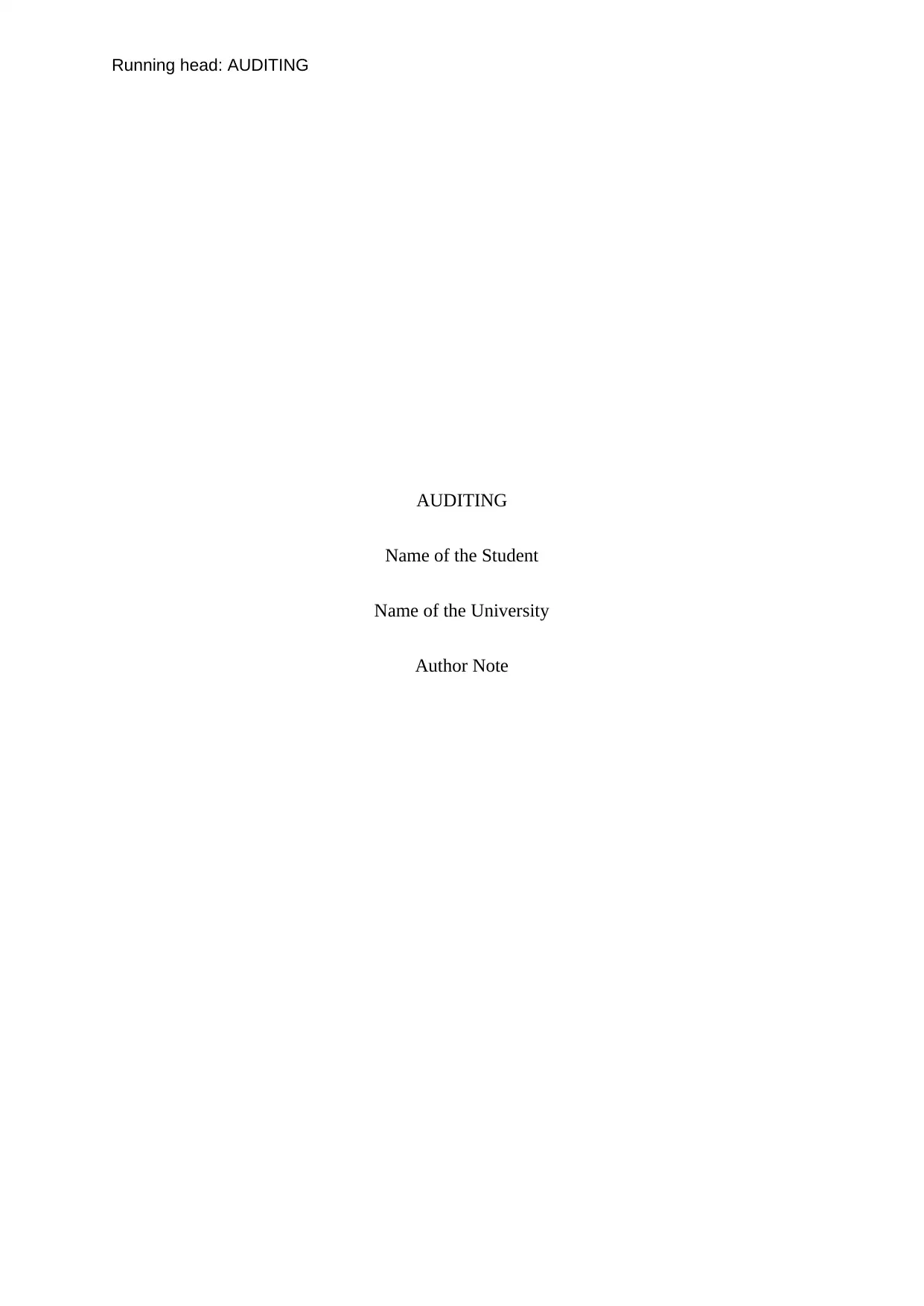
Running head: AUDITING
AUDITING
Name of the Student
Name of the University
Author Note
AUDITING
Name of the Student
Name of the University
Author Note
Paraphrase This Document
Need a fresh take? Get an instant paraphrase of this document with our AI Paraphraser
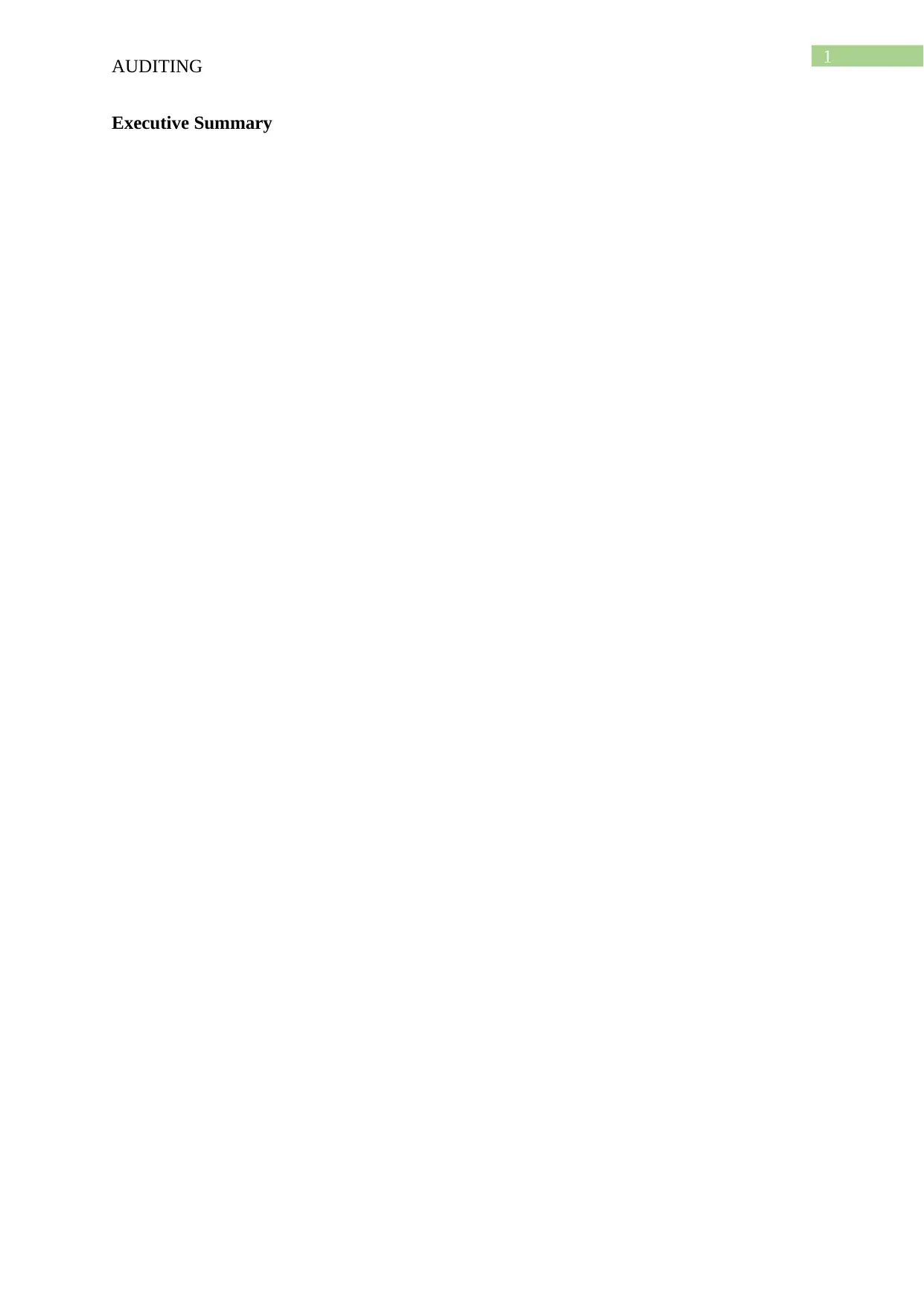
1
AUDITING
Executive Summary
AUDITING
Executive Summary
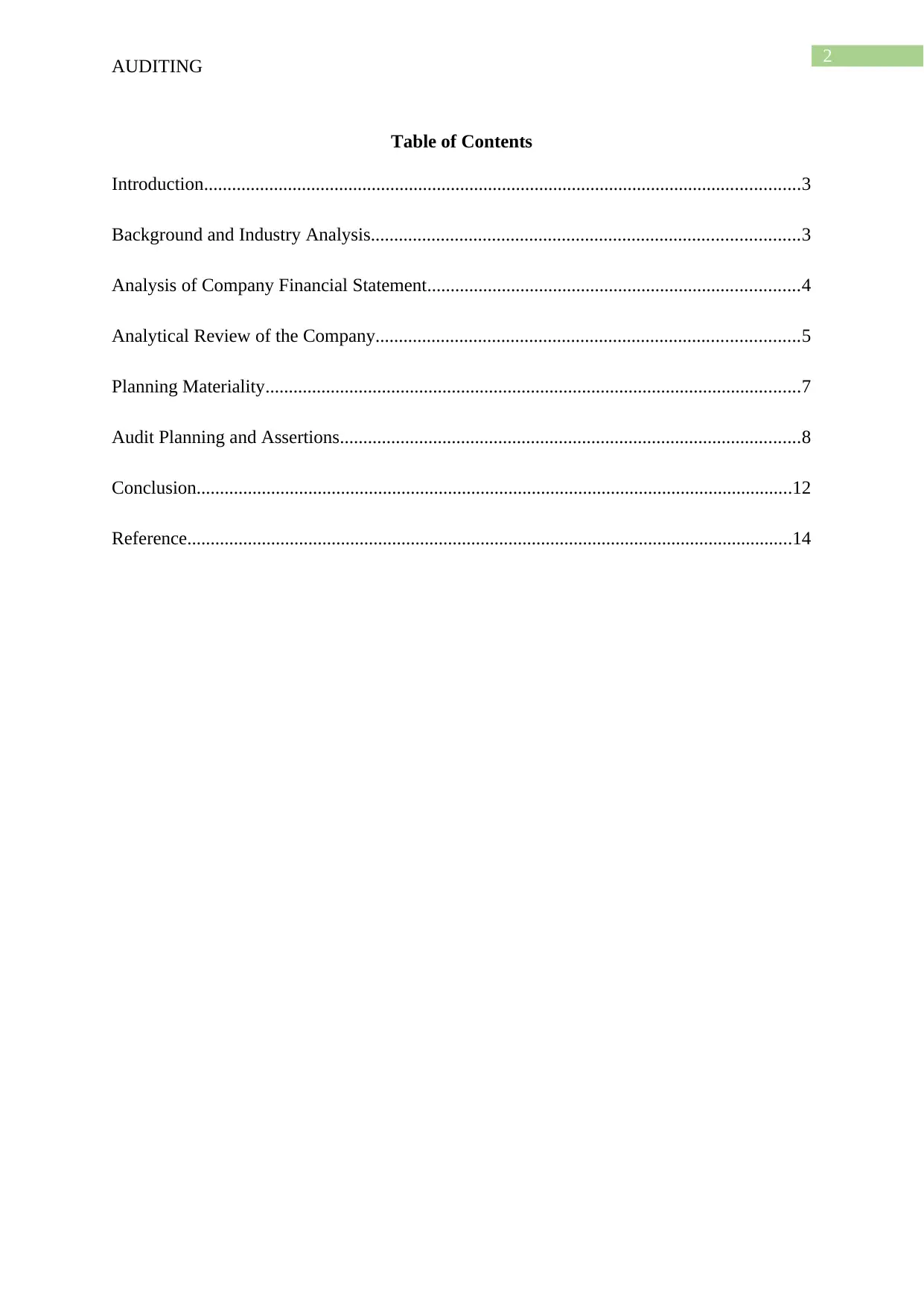
2
AUDITING
Table of Contents
Introduction................................................................................................................................3
Background and Industry Analysis............................................................................................3
Analysis of Company Financial Statement................................................................................4
Analytical Review of the Company...........................................................................................5
Planning Materiality...................................................................................................................7
Audit Planning and Assertions...................................................................................................8
Conclusion................................................................................................................................12
Reference..................................................................................................................................14
AUDITING
Table of Contents
Introduction................................................................................................................................3
Background and Industry Analysis............................................................................................3
Analysis of Company Financial Statement................................................................................4
Analytical Review of the Company...........................................................................................5
Planning Materiality...................................................................................................................7
Audit Planning and Assertions...................................................................................................8
Conclusion................................................................................................................................12
Reference..................................................................................................................................14
⊘ This is a preview!⊘
Do you want full access?
Subscribe today to unlock all pages.

Trusted by 1+ million students worldwide
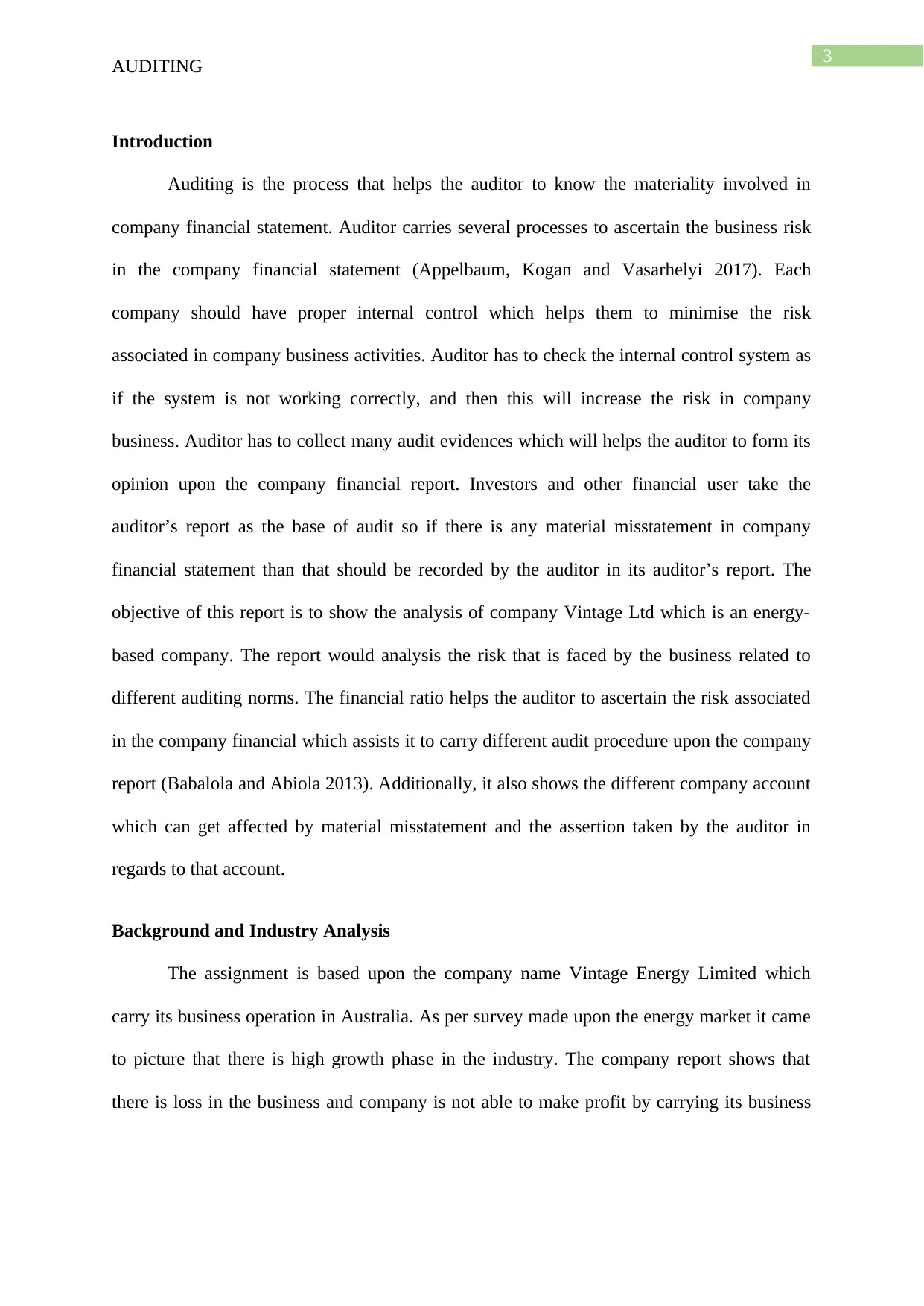
3
AUDITING
Introduction
Auditing is the process that helps the auditor to know the materiality involved in
company financial statement. Auditor carries several processes to ascertain the business risk
in the company financial statement (Appelbaum, Kogan and Vasarhelyi 2017). Each
company should have proper internal control which helps them to minimise the risk
associated in company business activities. Auditor has to check the internal control system as
if the system is not working correctly, and then this will increase the risk in company
business. Auditor has to collect many audit evidences which will helps the auditor to form its
opinion upon the company financial report. Investors and other financial user take the
auditor’s report as the base of audit so if there is any material misstatement in company
financial statement than that should be recorded by the auditor in its auditor’s report. The
objective of this report is to show the analysis of company Vintage Ltd which is an energy-
based company. The report would analysis the risk that is faced by the business related to
different auditing norms. The financial ratio helps the auditor to ascertain the risk associated
in the company financial which assists it to carry different audit procedure upon the company
report (Babalola and Abiola 2013). Additionally, it also shows the different company account
which can get affected by material misstatement and the assertion taken by the auditor in
regards to that account.
Background and Industry Analysis
The assignment is based upon the company name Vintage Energy Limited which
carry its business operation in Australia. As per survey made upon the energy market it came
to picture that there is high growth phase in the industry. The company report shows that
there is loss in the business and company is not able to make profit by carrying its business
AUDITING
Introduction
Auditing is the process that helps the auditor to know the materiality involved in
company financial statement. Auditor carries several processes to ascertain the business risk
in the company financial statement (Appelbaum, Kogan and Vasarhelyi 2017). Each
company should have proper internal control which helps them to minimise the risk
associated in company business activities. Auditor has to check the internal control system as
if the system is not working correctly, and then this will increase the risk in company
business. Auditor has to collect many audit evidences which will helps the auditor to form its
opinion upon the company financial report. Investors and other financial user take the
auditor’s report as the base of audit so if there is any material misstatement in company
financial statement than that should be recorded by the auditor in its auditor’s report. The
objective of this report is to show the analysis of company Vintage Ltd which is an energy-
based company. The report would analysis the risk that is faced by the business related to
different auditing norms. The financial ratio helps the auditor to ascertain the risk associated
in the company financial which assists it to carry different audit procedure upon the company
report (Babalola and Abiola 2013). Additionally, it also shows the different company account
which can get affected by material misstatement and the assertion taken by the auditor in
regards to that account.
Background and Industry Analysis
The assignment is based upon the company name Vintage Energy Limited which
carry its business operation in Australia. As per survey made upon the energy market it came
to picture that there is high growth phase in the industry. The company report shows that
there is loss in the business and company is not able to make profit by carrying its business
Paraphrase This Document
Need a fresh take? Get an instant paraphrase of this document with our AI Paraphraser
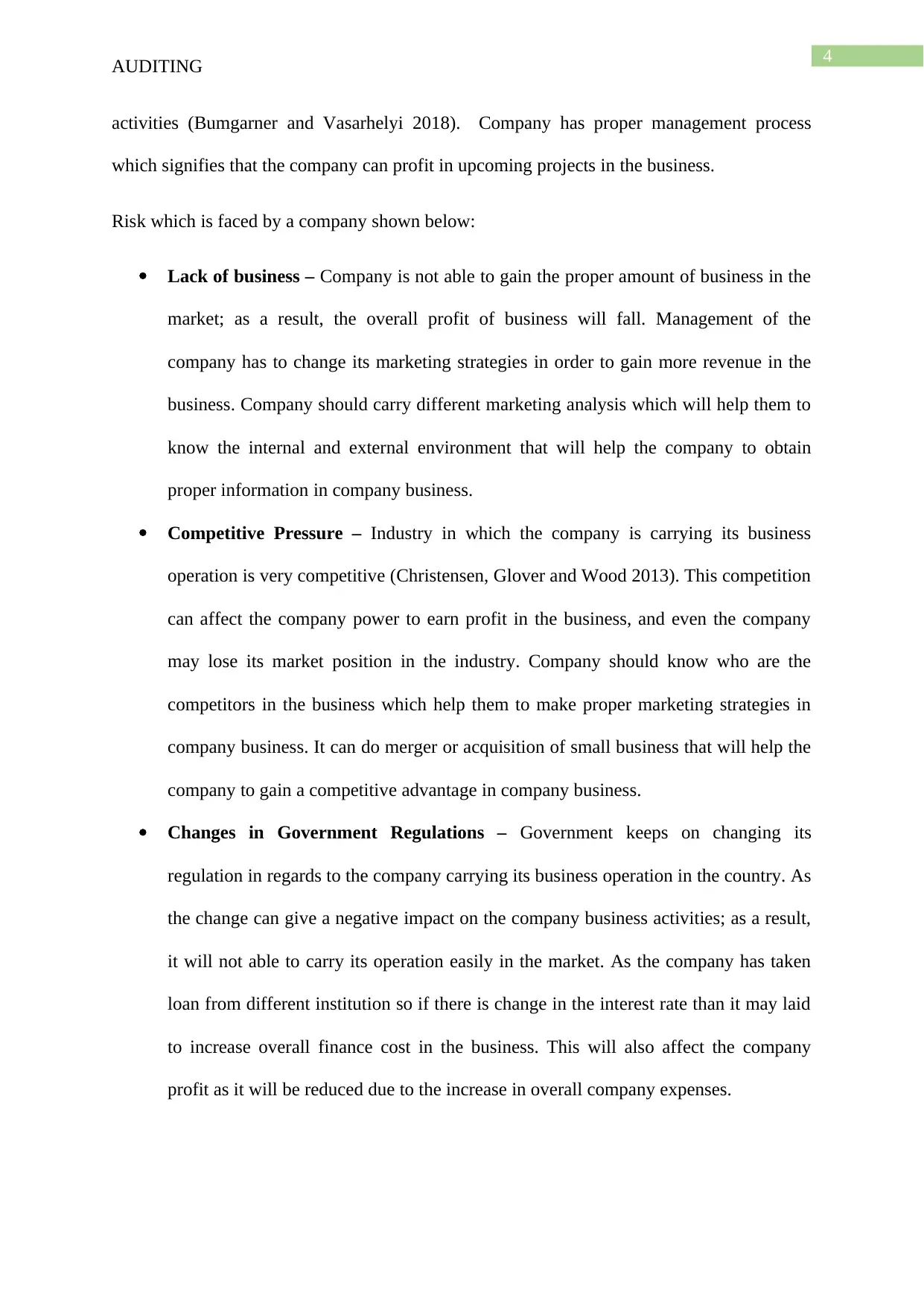
4
AUDITING
activities (Bumgarner and Vasarhelyi 2018). Company has proper management process
which signifies that the company can profit in upcoming projects in the business.
Risk which is faced by a company shown below:
Lack of business – Company is not able to gain the proper amount of business in the
market; as a result, the overall profit of business will fall. Management of the
company has to change its marketing strategies in order to gain more revenue in the
business. Company should carry different marketing analysis which will help them to
know the internal and external environment that will help the company to obtain
proper information in company business.
Competitive Pressure – Industry in which the company is carrying its business
operation is very competitive (Christensen, Glover and Wood 2013). This competition
can affect the company power to earn profit in the business, and even the company
may lose its market position in the industry. Company should know who are the
competitors in the business which help them to make proper marketing strategies in
company business. It can do merger or acquisition of small business that will help the
company to gain a competitive advantage in company business.
Changes in Government Regulations – Government keeps on changing its
regulation in regards to the company carrying its business operation in the country. As
the change can give a negative impact on the company business activities; as a result,
it will not able to carry its operation easily in the market. As the company has taken
loan from different institution so if there is change in the interest rate than it may laid
to increase overall finance cost in the business. This will also affect the company
profit as it will be reduced due to the increase in overall company expenses.
AUDITING
activities (Bumgarner and Vasarhelyi 2018). Company has proper management process
which signifies that the company can profit in upcoming projects in the business.
Risk which is faced by a company shown below:
Lack of business – Company is not able to gain the proper amount of business in the
market; as a result, the overall profit of business will fall. Management of the
company has to change its marketing strategies in order to gain more revenue in the
business. Company should carry different marketing analysis which will help them to
know the internal and external environment that will help the company to obtain
proper information in company business.
Competitive Pressure – Industry in which the company is carrying its business
operation is very competitive (Christensen, Glover and Wood 2013). This competition
can affect the company power to earn profit in the business, and even the company
may lose its market position in the industry. Company should know who are the
competitors in the business which help them to make proper marketing strategies in
company business. It can do merger or acquisition of small business that will help the
company to gain a competitive advantage in company business.
Changes in Government Regulations – Government keeps on changing its
regulation in regards to the company carrying its business operation in the country. As
the change can give a negative impact on the company business activities; as a result,
it will not able to carry its operation easily in the market. As the company has taken
loan from different institution so if there is change in the interest rate than it may laid
to increase overall finance cost in the business. This will also affect the company
profit as it will be reduced due to the increase in overall company expenses.
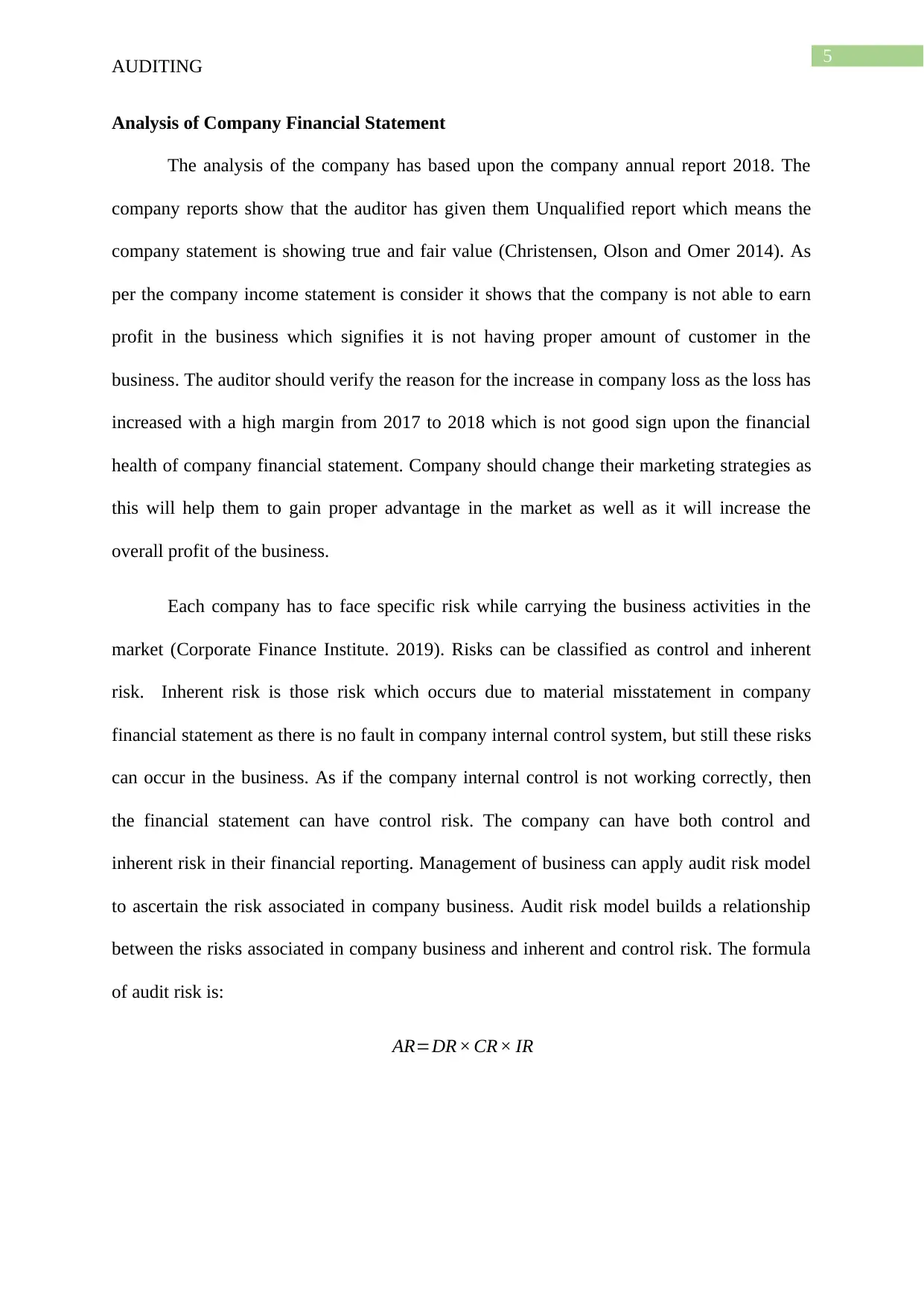
5
AUDITING
Analysis of Company Financial Statement
The analysis of the company has based upon the company annual report 2018. The
company reports show that the auditor has given them Unqualified report which means the
company statement is showing true and fair value (Christensen, Olson and Omer 2014). As
per the company income statement is consider it shows that the company is not able to earn
profit in the business which signifies it is not having proper amount of customer in the
business. The auditor should verify the reason for the increase in company loss as the loss has
increased with a high margin from 2017 to 2018 which is not good sign upon the financial
health of company financial statement. Company should change their marketing strategies as
this will help them to gain proper advantage in the market as well as it will increase the
overall profit of the business.
Each company has to face specific risk while carrying the business activities in the
market (Corporate Finance Institute. 2019). Risks can be classified as control and inherent
risk. Inherent risk is those risk which occurs due to material misstatement in company
financial statement as there is no fault in company internal control system, but still these risks
can occur in the business. As if the company internal control is not working correctly, then
the financial statement can have control risk. The company can have both control and
inherent risk in their financial reporting. Management of business can apply audit risk model
to ascertain the risk associated in company business. Audit risk model builds a relationship
between the risks associated in company business and inherent and control risk. The formula
of audit risk is:
AR=DR × CR× IR
AUDITING
Analysis of Company Financial Statement
The analysis of the company has based upon the company annual report 2018. The
company reports show that the auditor has given them Unqualified report which means the
company statement is showing true and fair value (Christensen, Olson and Omer 2014). As
per the company income statement is consider it shows that the company is not able to earn
profit in the business which signifies it is not having proper amount of customer in the
business. The auditor should verify the reason for the increase in company loss as the loss has
increased with a high margin from 2017 to 2018 which is not good sign upon the financial
health of company financial statement. Company should change their marketing strategies as
this will help them to gain proper advantage in the market as well as it will increase the
overall profit of the business.
Each company has to face specific risk while carrying the business activities in the
market (Corporate Finance Institute. 2019). Risks can be classified as control and inherent
risk. Inherent risk is those risk which occurs due to material misstatement in company
financial statement as there is no fault in company internal control system, but still these risks
can occur in the business. As if the company internal control is not working correctly, then
the financial statement can have control risk. The company can have both control and
inherent risk in their financial reporting. Management of business can apply audit risk model
to ascertain the risk associated in company business. Audit risk model builds a relationship
between the risks associated in company business and inherent and control risk. The formula
of audit risk is:
AR=DR × CR× IR
⊘ This is a preview!⊘
Do you want full access?
Subscribe today to unlock all pages.

Trusted by 1+ million students worldwide
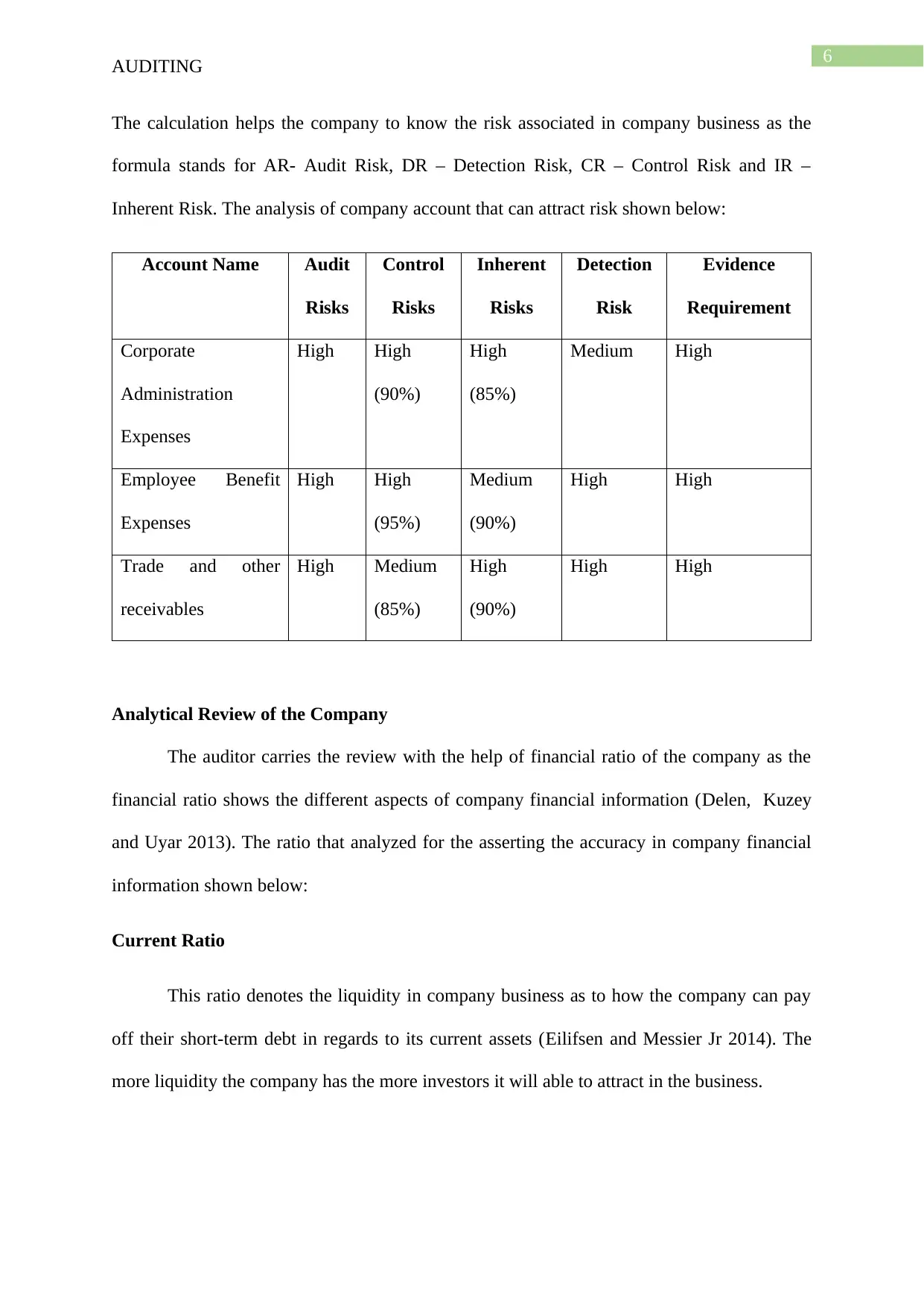
6
AUDITING
The calculation helps the company to know the risk associated in company business as the
formula stands for AR- Audit Risk, DR – Detection Risk, CR – Control Risk and IR –
Inherent Risk. The analysis of company account that can attract risk shown below:
Account Name Audit
Risks
Control
Risks
Inherent
Risks
Detection
Risk
Evidence
Requirement
Corporate
Administration
Expenses
High High
(90%)
High
(85%)
Medium High
Employee Benefit
Expenses
High High
(95%)
Medium
(90%)
High High
Trade and other
receivables
High Medium
(85%)
High
(90%)
High High
Analytical Review of the Company
The auditor carries the review with the help of financial ratio of the company as the
financial ratio shows the different aspects of company financial information (Delen, Kuzey
and Uyar 2013). The ratio that analyzed for the asserting the accuracy in company financial
information shown below:
Current Ratio
This ratio denotes the liquidity in company business as to how the company can pay
off their short-term debt in regards to its current assets (Eilifsen and Messier Jr 2014). The
more liquidity the company has the more investors it will able to attract in the business.
AUDITING
The calculation helps the company to know the risk associated in company business as the
formula stands for AR- Audit Risk, DR – Detection Risk, CR – Control Risk and IR –
Inherent Risk. The analysis of company account that can attract risk shown below:
Account Name Audit
Risks
Control
Risks
Inherent
Risks
Detection
Risk
Evidence
Requirement
Corporate
Administration
Expenses
High High
(90%)
High
(85%)
Medium High
Employee Benefit
Expenses
High High
(95%)
Medium
(90%)
High High
Trade and other
receivables
High Medium
(85%)
High
(90%)
High High
Analytical Review of the Company
The auditor carries the review with the help of financial ratio of the company as the
financial ratio shows the different aspects of company financial information (Delen, Kuzey
and Uyar 2013). The ratio that analyzed for the asserting the accuracy in company financial
information shown below:
Current Ratio
This ratio denotes the liquidity in company business as to how the company can pay
off their short-term debt in regards to its current assets (Eilifsen and Messier Jr 2014). The
more liquidity the company has the more investors it will able to attract in the business.
Paraphrase This Document
Need a fresh take? Get an instant paraphrase of this document with our AI Paraphraser
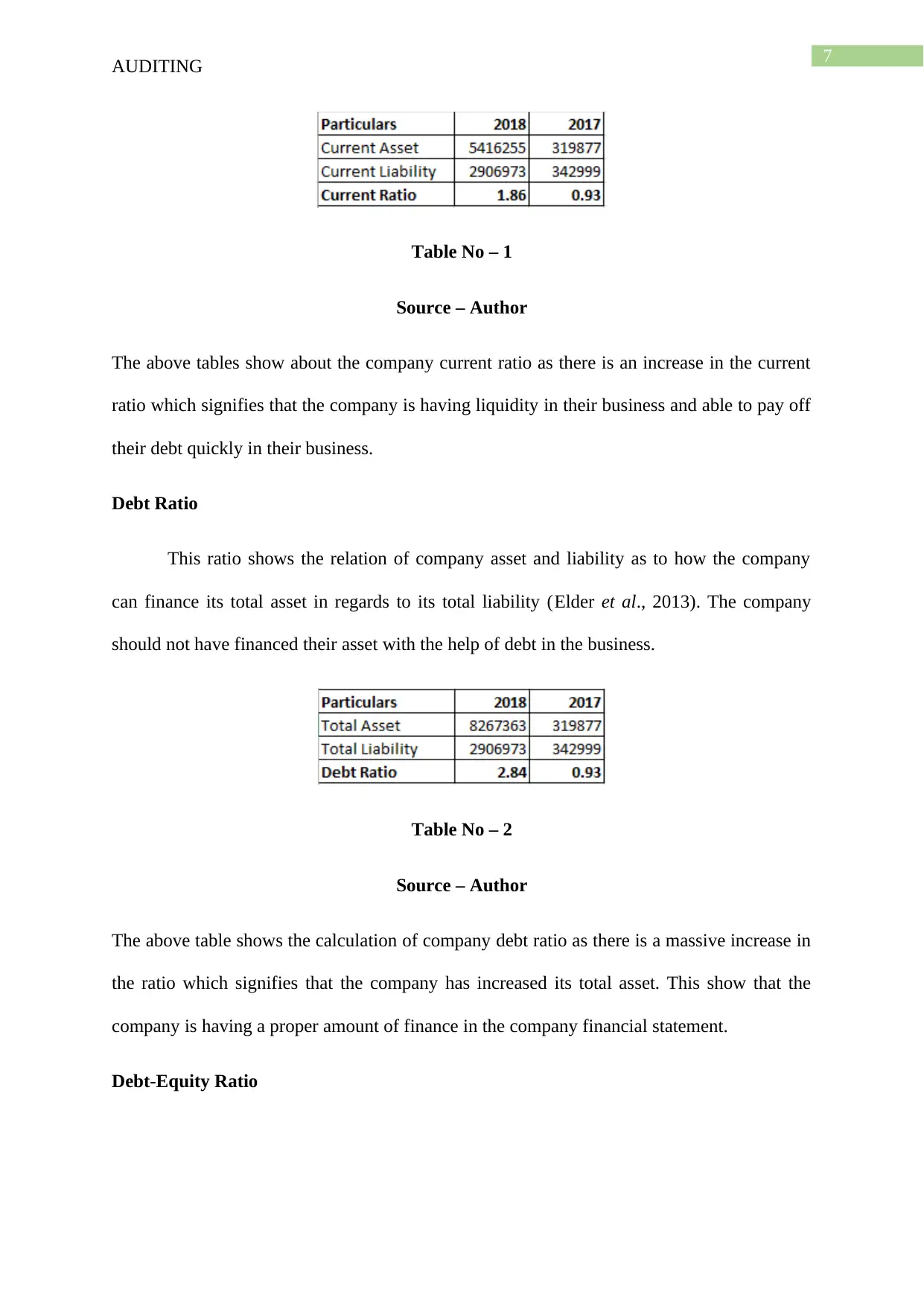
7
AUDITING
Table No – 1
Source – Author
The above tables show about the company current ratio as there is an increase in the current
ratio which signifies that the company is having liquidity in their business and able to pay off
their debt quickly in their business.
Debt Ratio
This ratio shows the relation of company asset and liability as to how the company
can finance its total asset in regards to its total liability (Elder et al., 2013). The company
should not have financed their asset with the help of debt in the business.
Table No – 2
Source – Author
The above table shows the calculation of company debt ratio as there is a massive increase in
the ratio which signifies that the company has increased its total asset. This show that the
company is having a proper amount of finance in the company financial statement.
Debt-Equity Ratio
AUDITING
Table No – 1
Source – Author
The above tables show about the company current ratio as there is an increase in the current
ratio which signifies that the company is having liquidity in their business and able to pay off
their debt quickly in their business.
Debt Ratio
This ratio shows the relation of company asset and liability as to how the company
can finance its total asset in regards to its total liability (Elder et al., 2013). The company
should not have financed their asset with the help of debt in the business.
Table No – 2
Source – Author
The above table shows the calculation of company debt ratio as there is a massive increase in
the ratio which signifies that the company has increased its total asset. This show that the
company is having a proper amount of finance in the company financial statement.
Debt-Equity Ratio
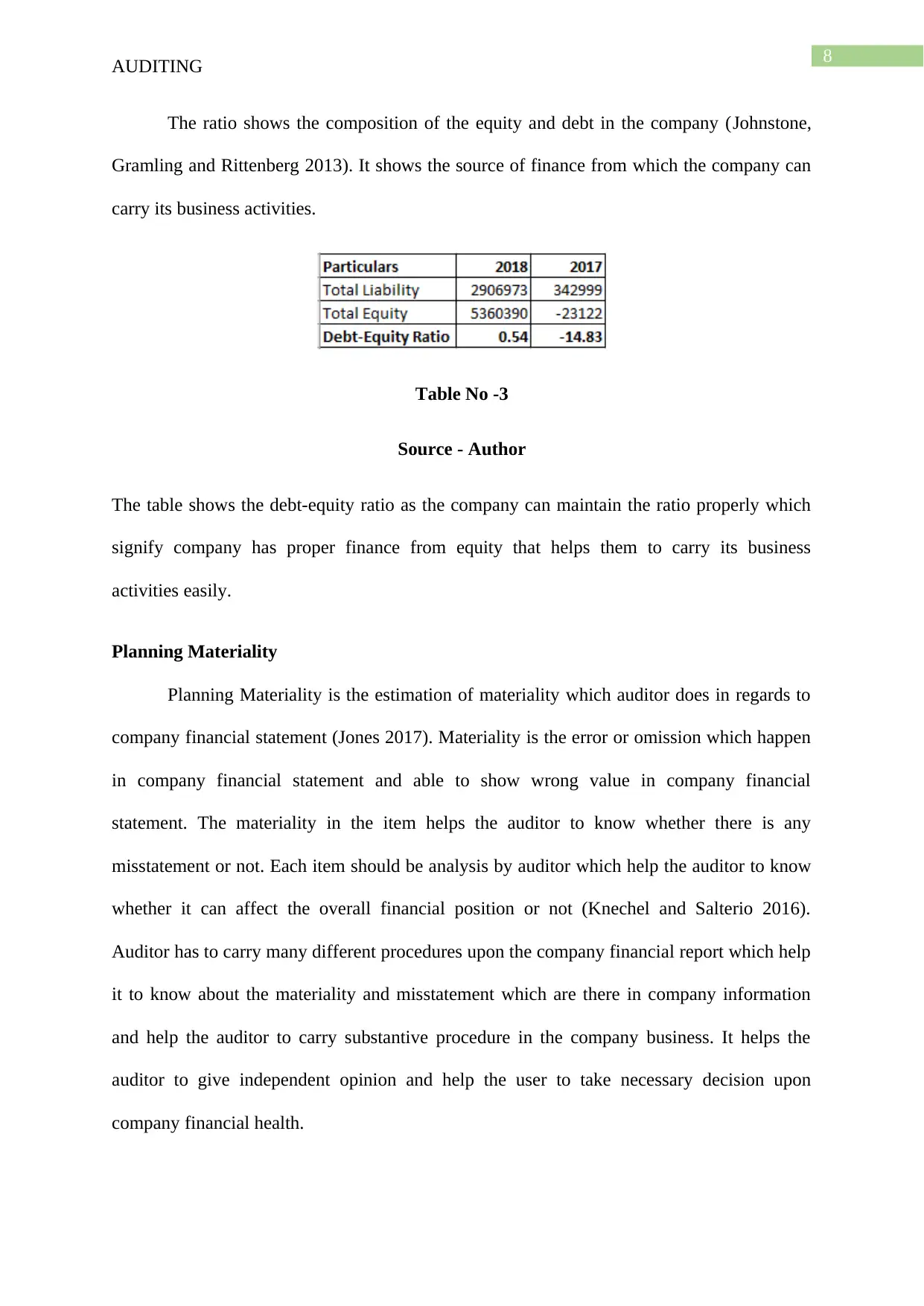
8
AUDITING
The ratio shows the composition of the equity and debt in the company (Johnstone,
Gramling and Rittenberg 2013). It shows the source of finance from which the company can
carry its business activities.
Table No -3
Source - Author
The table shows the debt-equity ratio as the company can maintain the ratio properly which
signify company has proper finance from equity that helps them to carry its business
activities easily.
Planning Materiality
Planning Materiality is the estimation of materiality which auditor does in regards to
company financial statement (Jones 2017). Materiality is the error or omission which happen
in company financial statement and able to show wrong value in company financial
statement. The materiality in the item helps the auditor to know whether there is any
misstatement or not. Each item should be analysis by auditor which help the auditor to know
whether it can affect the overall financial position or not (Knechel and Salterio 2016).
Auditor has to carry many different procedures upon the company financial report which help
it to know about the materiality and misstatement which are there in company information
and help the auditor to carry substantive procedure in the company business. It helps the
auditor to give independent opinion and help the user to take necessary decision upon
company financial health.
AUDITING
The ratio shows the composition of the equity and debt in the company (Johnstone,
Gramling and Rittenberg 2013). It shows the source of finance from which the company can
carry its business activities.
Table No -3
Source - Author
The table shows the debt-equity ratio as the company can maintain the ratio properly which
signify company has proper finance from equity that helps them to carry its business
activities easily.
Planning Materiality
Planning Materiality is the estimation of materiality which auditor does in regards to
company financial statement (Jones 2017). Materiality is the error or omission which happen
in company financial statement and able to show wrong value in company financial
statement. The materiality in the item helps the auditor to know whether there is any
misstatement or not. Each item should be analysis by auditor which help the auditor to know
whether it can affect the overall financial position or not (Knechel and Salterio 2016).
Auditor has to carry many different procedures upon the company financial report which help
it to know about the materiality and misstatement which are there in company information
and help the auditor to carry substantive procedure in the company business. It helps the
auditor to give independent opinion and help the user to take necessary decision upon
company financial health.
⊘ This is a preview!⊘
Do you want full access?
Subscribe today to unlock all pages.

Trusted by 1+ million students worldwide
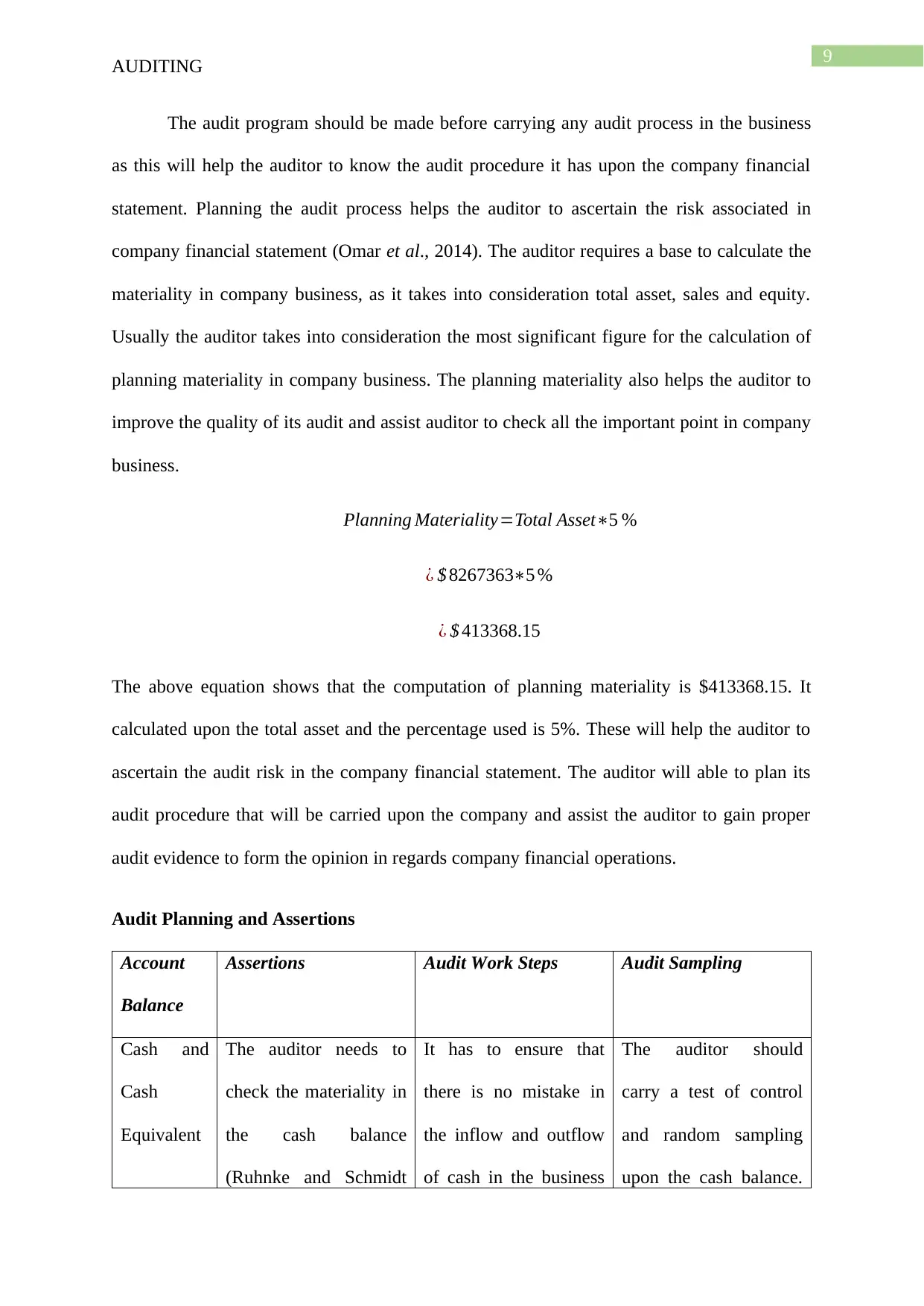
9
AUDITING
The audit program should be made before carrying any audit process in the business
as this will help the auditor to know the audit procedure it has upon the company financial
statement. Planning the audit process helps the auditor to ascertain the risk associated in
company financial statement (Omar et al., 2014). The auditor requires a base to calculate the
materiality in company business, as it takes into consideration total asset, sales and equity.
Usually the auditor takes into consideration the most significant figure for the calculation of
planning materiality in company business. The planning materiality also helps the auditor to
improve the quality of its audit and assist auditor to check all the important point in company
business.
Planning Materiality=Total Asset∗5 %
¿ $ 8267363∗5 %
¿ $ 413368.15
The above equation shows that the computation of planning materiality is $413368.15. It
calculated upon the total asset and the percentage used is 5%. These will help the auditor to
ascertain the audit risk in the company financial statement. The auditor will able to plan its
audit procedure that will be carried upon the company and assist the auditor to gain proper
audit evidence to form the opinion in regards company financial operations.
Audit Planning and Assertions
Account
Balance
Assertions Audit Work Steps Audit Sampling
Cash and
Cash
Equivalent
The auditor needs to
check the materiality in
the cash balance
(Ruhnke and Schmidt
It has to ensure that
there is no mistake in
the inflow and outflow
of cash in the business
The auditor should
carry a test of control
and random sampling
upon the cash balance.
AUDITING
The audit program should be made before carrying any audit process in the business
as this will help the auditor to know the audit procedure it has upon the company financial
statement. Planning the audit process helps the auditor to ascertain the risk associated in
company financial statement (Omar et al., 2014). The auditor requires a base to calculate the
materiality in company business, as it takes into consideration total asset, sales and equity.
Usually the auditor takes into consideration the most significant figure for the calculation of
planning materiality in company business. The planning materiality also helps the auditor to
improve the quality of its audit and assist auditor to check all the important point in company
business.
Planning Materiality=Total Asset∗5 %
¿ $ 8267363∗5 %
¿ $ 413368.15
The above equation shows that the computation of planning materiality is $413368.15. It
calculated upon the total asset and the percentage used is 5%. These will help the auditor to
ascertain the audit risk in the company financial statement. The auditor will able to plan its
audit procedure that will be carried upon the company and assist the auditor to gain proper
audit evidence to form the opinion in regards company financial operations.
Audit Planning and Assertions
Account
Balance
Assertions Audit Work Steps Audit Sampling
Cash and
Cash
Equivalent
The auditor needs to
check the materiality in
the cash balance
(Ruhnke and Schmidt
It has to ensure that
there is no mistake in
the inflow and outflow
of cash in the business
The auditor should
carry a test of control
and random sampling
upon the cash balance.
Paraphrase This Document
Need a fresh take? Get an instant paraphrase of this document with our AI Paraphraser
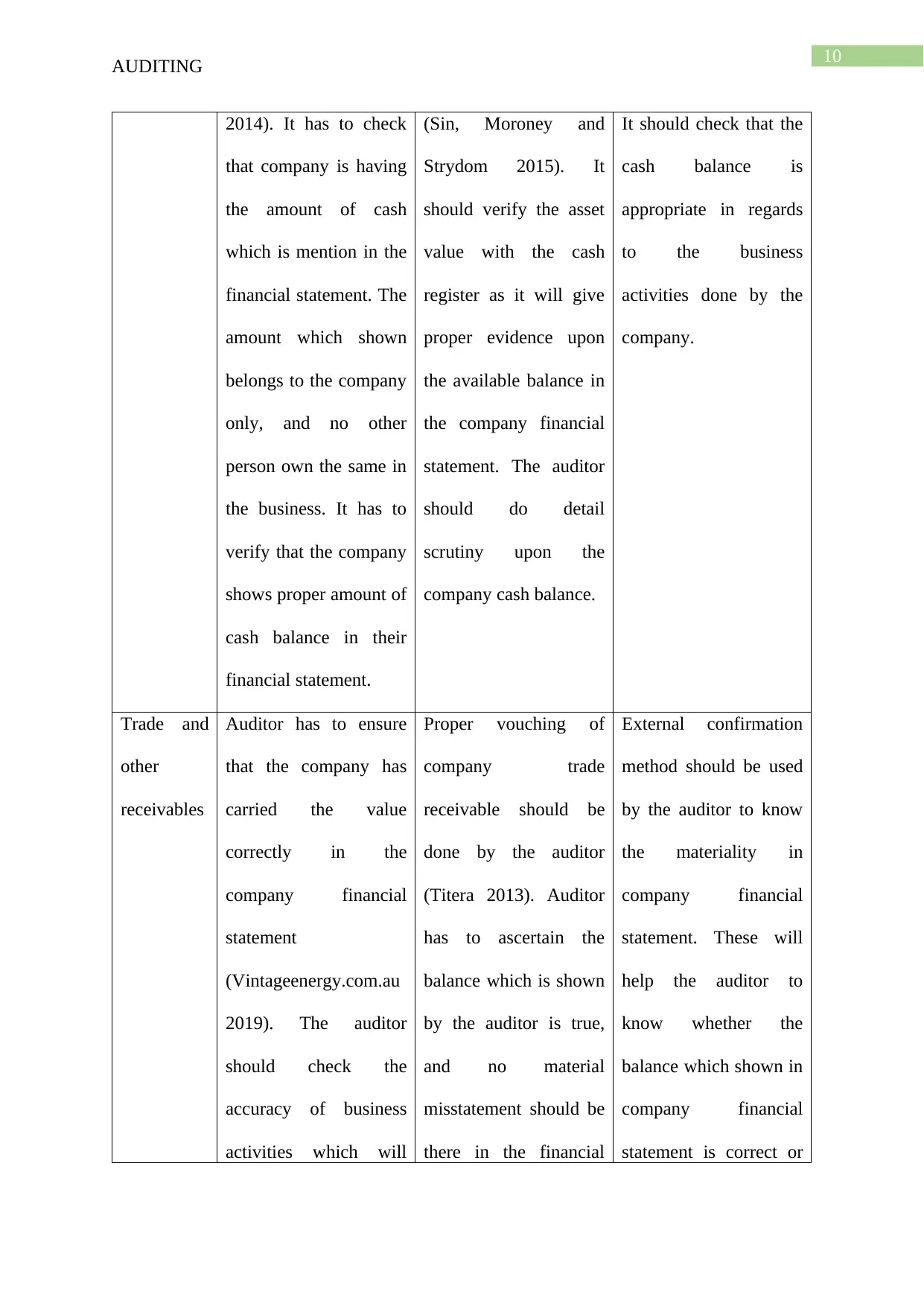
10
AUDITING
2014). It has to check
that company is having
the amount of cash
which is mention in the
financial statement. The
amount which shown
belongs to the company
only, and no other
person own the same in
the business. It has to
verify that the company
shows proper amount of
cash balance in their
financial statement.
(Sin, Moroney and
Strydom 2015). It
should verify the asset
value with the cash
register as it will give
proper evidence upon
the available balance in
the company financial
statement. The auditor
should do detail
scrutiny upon the
company cash balance.
It should check that the
cash balance is
appropriate in regards
to the business
activities done by the
company.
Trade and
other
receivables
Auditor has to ensure
that the company has
carried the value
correctly in the
company financial
statement
(Vintageenergy.com.au
2019). The auditor
should check the
accuracy of business
activities which will
Proper vouching of
company trade
receivable should be
done by the auditor
(Titera 2013). Auditor
has to ascertain the
balance which is shown
by the auditor is true,
and no material
misstatement should be
there in the financial
External confirmation
method should be used
by the auditor to know
the materiality in
company financial
statement. These will
help the auditor to
know whether the
balance which shown in
company financial
statement is correct or
AUDITING
2014). It has to check
that company is having
the amount of cash
which is mention in the
financial statement. The
amount which shown
belongs to the company
only, and no other
person own the same in
the business. It has to
verify that the company
shows proper amount of
cash balance in their
financial statement.
(Sin, Moroney and
Strydom 2015). It
should verify the asset
value with the cash
register as it will give
proper evidence upon
the available balance in
the company financial
statement. The auditor
should do detail
scrutiny upon the
company cash balance.
It should check that the
cash balance is
appropriate in regards
to the business
activities done by the
company.
Trade and
other
receivables
Auditor has to ensure
that the company has
carried the value
correctly in the
company financial
statement
(Vintageenergy.com.au
2019). The auditor
should check the
accuracy of business
activities which will
Proper vouching of
company trade
receivable should be
done by the auditor
(Titera 2013). Auditor
has to ascertain the
balance which is shown
by the auditor is true,
and no material
misstatement should be
there in the financial
External confirmation
method should be used
by the auditor to know
the materiality in
company financial
statement. These will
help the auditor to
know whether the
balance which shown in
company financial
statement is correct or
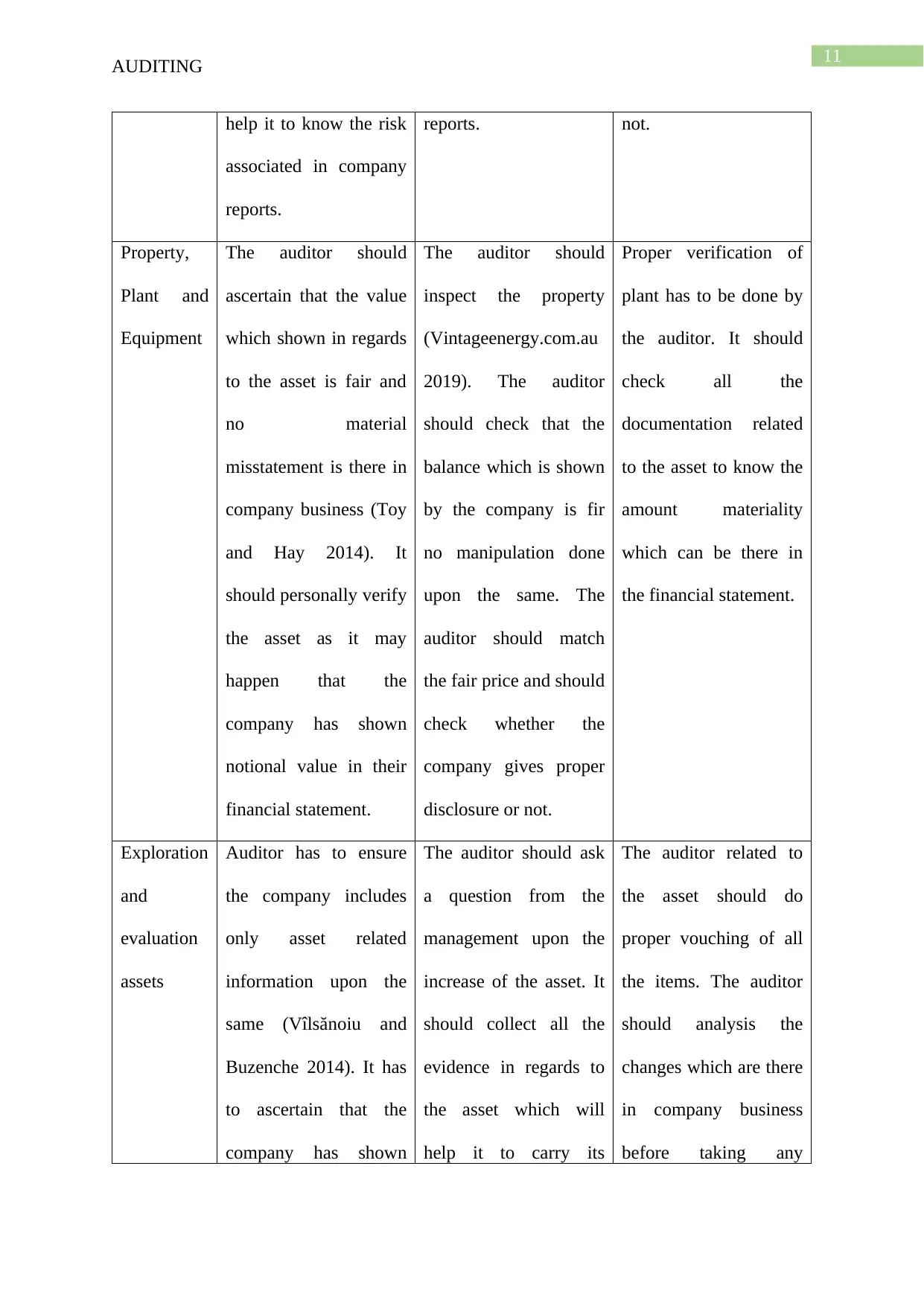
11
AUDITING
help it to know the risk
associated in company
reports.
reports. not.
Property,
Plant and
Equipment
The auditor should
ascertain that the value
which shown in regards
to the asset is fair and
no material
misstatement is there in
company business (Toy
and Hay 2014). It
should personally verify
the asset as it may
happen that the
company has shown
notional value in their
financial statement.
The auditor should
inspect the property
(Vintageenergy.com.au
2019). The auditor
should check that the
balance which is shown
by the company is fir
no manipulation done
upon the same. The
auditor should match
the fair price and should
check whether the
company gives proper
disclosure or not.
Proper verification of
plant has to be done by
the auditor. It should
check all the
documentation related
to the asset to know the
amount materiality
which can be there in
the financial statement.
Exploration
and
evaluation
assets
Auditor has to ensure
the company includes
only asset related
information upon the
same (Vîlsănoiu and
Buzenche 2014). It has
to ascertain that the
company has shown
The auditor should ask
a question from the
management upon the
increase of the asset. It
should collect all the
evidence in regards to
the asset which will
help it to carry its
The auditor related to
the asset should do
proper vouching of all
the items. The auditor
should analysis the
changes which are there
in company business
before taking any
AUDITING
help it to know the risk
associated in company
reports.
reports. not.
Property,
Plant and
Equipment
The auditor should
ascertain that the value
which shown in regards
to the asset is fair and
no material
misstatement is there in
company business (Toy
and Hay 2014). It
should personally verify
the asset as it may
happen that the
company has shown
notional value in their
financial statement.
The auditor should
inspect the property
(Vintageenergy.com.au
2019). The auditor
should check that the
balance which is shown
by the company is fir
no manipulation done
upon the same. The
auditor should match
the fair price and should
check whether the
company gives proper
disclosure or not.
Proper verification of
plant has to be done by
the auditor. It should
check all the
documentation related
to the asset to know the
amount materiality
which can be there in
the financial statement.
Exploration
and
evaluation
assets
Auditor has to ensure
the company includes
only asset related
information upon the
same (Vîlsănoiu and
Buzenche 2014). It has
to ascertain that the
company has shown
The auditor should ask
a question from the
management upon the
increase of the asset. It
should collect all the
evidence in regards to
the asset which will
help it to carry its
The auditor related to
the asset should do
proper vouching of all
the items. The auditor
should analysis the
changes which are there
in company business
before taking any
⊘ This is a preview!⊘
Do you want full access?
Subscribe today to unlock all pages.

Trusted by 1+ million students worldwide
1 out of 19
Related Documents
Your All-in-One AI-Powered Toolkit for Academic Success.
+13062052269
info@desklib.com
Available 24*7 on WhatsApp / Email
![[object Object]](/_next/static/media/star-bottom.7253800d.svg)
Unlock your academic potential
Copyright © 2020–2025 A2Z Services. All Rights Reserved. Developed and managed by ZUCOL.




